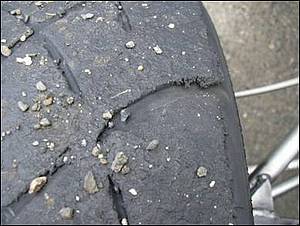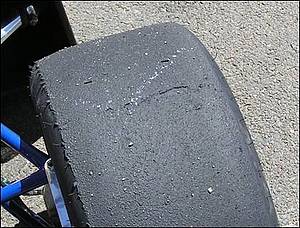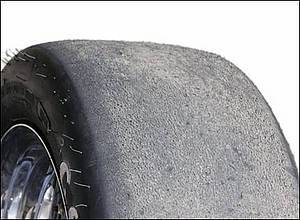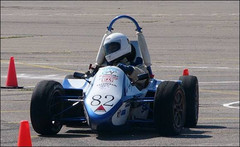Last month I promised I would talk about tyres. The choice of tyre is one of the fundamental choices that should be made at the very first stage of design planning. Every facet of the car performance is reacted through the four contact patches.
Fundamentally, brakes don’t stop the car, the engine doesn’t accelerate the car and the steering doesn’t turn the car. All these tasks are achieved as a result a reaction between the tyre contact patch and the ground. Never forget that!
Claude Rouelle, at his 2003 Seminar in Sydney, alluded to the existence of a tyre which would ‘Take 2 seconds off your lap time’. Ears pricked up immediately and many hours of ‘Googling’ ensued. You should be warned that Claude sometimes makes provocative statements intended specifically to raise the level of research. There may or may not be a ‘2 second tyre’ out there, but anyone who took the bait and went off doing further research now know more about tyres than they did before, and I suspect that was Claude’s intention.
How do you choose the ‘best’ tyre? What is the best tyre? Why do some winning teams use one brand or size of a tyre whilst other winning teams use something completely different? The first two questions are almost impossible to answer, but the last one is easy. Once a team has made a tyre choice, then they must optimize their car package to make best use of their tyre.
The best tyre is not necessarily the softest or the widest or the most expensive. Tyre making is still something of a black art, and there are many things other than tread compound that makes a good tyre,
The first choice that must be made when choosing tyres is what size to use and this dictates the wheel size both diameter and width. There are some advantages in choosing a 10” dia, such as lower rotational inertia. 13” wheels usually offer a better choice of tyres, so one advantage may be cancelled by another. 10” wheels have less internal space to house brake and suspension components, and the suspension geometry desired may have some compromises at the chassis end. The short virtual swing axle popular with many teams will place the inner suspension pivots very close together, and the judges may not like the resultant load paths. If I were building a FS car, I would use 13” wheels, but that is just my opinion.
Teams should use whatever tyre data is available to help them make their choice. Most tyre companies have some tyre data available, but it may be incomplete and difficult to find. Goodyear, Hoosier and Avon, the tyre makes most popular with FS teams, have some data available on their websites. The importance of tyre data, both in the initial tyre choice and in making the best use of the chosen tyre, is shown by the formation of the FSAE tyre test consortium, where teams contributed to having certain tyres tested and the data being shared between all teams involved. This information will be extremely helpful to those teams, and it is not coincidental that the teams in the consortium are all leading FS or FSAE contenders.
Some tyre data is fairly simple to measure. It is easy to build a jig that measures the spring rate of the tyre at different inflation pressures, yet so few teams have done this. They go to great pains to calculate spring rates, motion ratios etc on the chassis, yet ignore the tyre spring rate! It is no secret that tyre spring rate is important, because every contemporary F1 car has almost no chassis springing, the compliance is almost entirely in the tyre as can be seen by the fantastic slow motion shots from Hockenheim each year.
You should be aware that different tyre makers often have different sidewall stiffness and therefore natural spring rate. For instance, the popular Hoosier FSAE tyre has a stiffer sidewall than the similar and equally popular Goodyear FSAE tyre. This means that a change from one tyre to the other will affect the springing and damping compromises on the car, especially at low pressure settings.
A radial ply tyre is likely to have a lower natural spring rate than a cross ply tyre, and so the car may be more sensitive to tyre pressure changes when on radials.
Each team should have a comprehensive dossier of tyre information, and it should be updated on an ongoing basis. This should be a team asset, rather than individual personal property which will be taken from the team when that member graduates.
Realistically, the choice of suitable tyres for a 200kg FS car is limited. Almost all competition tyres are designed for heavier cars, and with much longer endurance than required at FS.
There are companies like Goodyear and Hoosier who make tyres specifically designed for FSAE cars; however, they are usually optimized for the temperatures experienced at Detroit in May. Others, such as Avon in the UK, Dunlop in Japan and LeCont in Italy make tyres specifically designed for use by motorcycle engined hill-climb cars. Companies like Yokohama make tyres for motorcycle sidecar racers, which may or may not suit FS cars. Teams should be regular visitors to these company websites.
There are several publications out there relating directly to race tyres. Papers and books have been published by people like Chuck Hallum and Paul Haney and others. All these papers and books should be part of a team’s library assets.
A team should never choose tyres made for a one make or control racing series unless no other option is available! These tyres are made with long life, durability and equity of competition as a priority, and so will always generate less grip than optimum. FS tyres only need to last about 50 kilometers, and need to be fast from the outset. ‘Control’ tyres need to last much longer, are usually built for heavier cars. One aspect usually not considered is that circuit racers do not use the extreme steer angles that are seen in Formula Student competition.
We are starting to see some teams form strategic relationships with tyre companies, and Clemson were at Pontiac sporting Michelin radial ply tyres and Hankook Company makes special tyres for the South Korean teams. Watch this development. The tyre companies need to source the next generation of tyre engineers from somewhere, and Formula Student is an excellent place to recruit.
Tyres should be selected and the data studied before any decisions are made regarding camber curves and Ackermann etc.
‘Reading’ tyres should become second nature. Terms like ‘Schallmach waves’, ‘Tread area deflection’, ‘Hallum model’, etc will become second nature. Believe me, the judges will inspect your tyre wear patterns in great detail, and you better understand what they are ‘reading’ when they ask you! Most importantly, understand ‘tread graining’, a symptom of a poor setup.
Any search on tyre data, research and virtual modeling will bring you to the work of Pacejka, and difficult though it may be to follow, there is real information (read ‘speed’) in the Pacejka model. Beware though, his research is mainly based on passenger car tyres where heating of the tread compound is not a factor.
At a more basic level, having chosen your tyres and put a considerable dent in your team budget by purchasing them, what do you need to understand to make the best use of your investment?
Lots of good advice is ignored by even the smartest teams! Right up to formula 1, so we are all in good company.
Slick racing tyres only work properly when they are hot, at their optimum working pressure.
The old rule of thumb was that slick tyres worked best when the tyre temperature reached 100°C, although this seems very high for FS tyres. Temperatures of 80°C to 85°C are more suitable for these tyres.
The tyre temperature is generated from within the tyre rather than simply a result of friction between tyre tread and racing surface. Those who play squash know how important it is to warm up the ball before playing a game. This warmth comes from ‘exercising’ the rubber in the ball. Tyres are no different, the temperature is generated inside the tyre, so reading tyre tread temperatures can give very misleading information on setup. Some teams rig up IR heat sensors and test whilst logging data from these sensors. The information gained is useful but not complete. There is no substitute for measuring tyre core temperature across the tread using a needle type pyrometer.

Fig 2. Measuring tyre temperatures
This shows a standard digital thermometer with a needle type probe being used to measure tyre core temperature. There is no need to buy a special memory type tyre pyrometer for this task.
Racing tyres ‘cure’ a little every time they get hot, or are ‘heat cycled’. Cured or hard tyres are never fast, so rule one is to try control the number and intensity of heat cycles. A tyre that has gotten hot enough on the car to ‘go off’ (feels greasy and loses grip) has been destroyed and will never again offer the grip it once had, so NEVER abuse your tyres intentionally!
Tyres that have been over heated have a smooth shiny look, like rubber that has melted and re-hardened. Funny that! The softeners and plasticizers will have boiled away.

Fig 3. An overheated wet tyre caused by being used on a dry track
This picture shows a FS wet tyre that had been run in the dry. You can see how the rubber has melted and congealed, smearing into the rain grooves. Although this tyre had minimum use in the dry, and probably be recovered by rasping off all the dead rubber, this tyre has been seriously damaged.

Fig 4. This overheated tyre probably caused by using a compound that was too soft for the conditions.
This picture shows a tyre that has been overheated after very little use at Formula Student 2005. Yes, it is possible to choose tyres that are too soft!
If the first enemy of tyres is heat, the second is misalignment. Misalignment simply abrades the tyre away, probably overheating local areas of tread in the process. Sometimes misalignment is hard to see and measure. Indirect misalignment such as difference in tyre diameters, or mismatched caster or SAE angles across the car may contribute to tyre wear.
Always measure tyre diameters and fit them in matched pairs. Failure to do so makes corner weighing redundant.
Mismatched caster angles will cause the car to pull (to the side with the least caster) and the correction will impose a side load, wearing the tyre.
Teams need to be very careful with the amount of Ackermann they use. Much importance is placed on ‘Ackermann’ angles, yet the real importance of Ackermann is the difference in front wheel toe angles as the steering is turned. This can be affected by things other than Ackermann angle such as the steering rack position. Teams should understand the change in toe across the entire range of steering angles.
Excessive Ackermann angle will wear the tyre by causing the inner tyre to be dragged across the turn apex.
Uneven Ackermann across the car (usually caused by failing to centralize the rack before doing a wheel alignment or a bent steering arm) can cause problems that may be difficult to analyze.
Obviously, camber and toe angles have to be optimal for the tyre, otherwise local overheating will occur and the tyre will quickly be ruined. If the tyre ever goes over on the outside edge (Insufficient negative camber at some stage of operation) the tyre will be ruined in short order. Not only that, but once that tyre wear has started, the tyre cannot be easily recovered. Reversing the tyre on the rim may extend the competitive life, but the tyre will never perform as well.
Tyres which have been very hot should be cooled immediately by deflating them and then cooling them with cold water to avoid boiling off any more of the plasticizers.
Overheating can be as a result of over inflation, either intended or not. The oxygen and moisture content of air will cause an increase in inflation pressure as the tyre warms up. Teams should know there is a benefit in tyre life and performance gained when the tyres are evacuated with a vacuum pump (even a vacuum cleaner), and then inflated with dry nitrogen (sometimes called “tyre gas”) yet very few do it. This practice reduces the amount of pressure fluctuation due to heat, and is mandated by law in aircraft tyres as a fire suppression requirement.
This picture was taken at Pontiac after the 2003 FSAE.

Fig 5 . Evidence of Schallamach waves on the Goodyear tyre fitted on a 2003 FSAE car
It shows a wave pattern on the inner edge of the tread, and some cupping wear in that part of the tread. This is caused by the aggressive camber settings used concentrating loads on the inner quarter of the tread. It is not an effect of incorrect toe setting, otherwise running between corners would erase the waves. This tyre has reached the end of its competitive life as the loaded section of the tread will have been cured.
A Design Judge looking at this tyre would want to see a more even dispersion of the load across the tread area and so would not be impressed. In this case, I suspect the team did not factor in the negative camber gain generated by caster whilst steering.
Tyre tread waves are instabilities that occur as interfaces between pliable tyre rubber and the rigid road surface slide past each other. When the rubber is forced across the road, either as a result of sliding, or the tyre running at a slip angle, the surface irregularities of the road exert oscillating forces on the tyre surface leading to energy dissipation through internal friction in the rubber. This is how heat is properly generated in tyres, rather than simple friction of the tyre sliding across the road surface, and explains why simple measurements of tyre temperature at the surface can be misleading.
Wave patterns appear on the surface of a correctly used slick racing tyre. They are a side effect of the ‘Grip/Slip’ operating parameter of these tyres. They are perfectly normal, and should not be mistaken for ‘graining’ which is evidence of tyre abuse.
These wave marks run around the tyre in the direction of rotation, and there seems to be some relationship between the spacing of these wave marks and the optimum slip angle for any given tyre. Don’t bother rasping them off, because if you are using the tyres correctly they will come right back.
Graining occurs when a slick tyre is overloaded in shear, especially before the tyre is fully warmed up or before the construction has been allowed to settle after the first heat cycle.
The stresses in a tyre when fitted to a rim are very different to those in manufacture, so it does give the tyre a better chance of performing as designed if the tyre is permitted to settle after the first heat cycle.
Tyres will work better and last longer if they are mounted and used moderately (‘run in’) and then allowed to cool and settle for at least 24 hours before use. All tyre makers recommend this practice. One thing not often discussed is the importance of obeying rotational arrows or other tyre markings on slick tyres. This is important especially when fitting new tyres, otherwise the tread rubber splice may begin to open as engine or braking torque is applied before the tyre has been run in.

Fig 6 . Tyre splice opening.
This picture shows a tread splice opening because the tyre was fitted in the wrong direction. Once the tyre has cured, the direction of rotation is less important.
Tyres run flat out when new may have a marginally faster lap time for one or two laps, but only if the chassis is optimized for these new tyres. Think about that! Then these tyres deteriorate rapidly. Fitting brand new tyres for an Endurance run is certainly not a good practice, properly run in tyres will be faster and more stable over a long run.

Fig 7 . Damage caused by running hard on a new tyre.
It shows that damage is occurring to the tyre after only a few laps of running.
This tyre is close to the limit of where it can be recovered, but it will never perform as well as a properly prepared tyres.
Hot tyres should not be allowed to cool with the vehicle sitting on the ground. This practice can cause flats to develop in the carcass of the tyre and this will not recover until the tyre has been fully heated again. Meanwhile the warm up laps will be vibratory ones.
If the car has to be moved around on hot tyres, then the hot rubber will pick up stones, debris, grass etc. The tyres can not perform properly until this debris has been removed, and any attempt to drive on the tyres before they are cleaned can result in a puncture or other tyre damage. Teams are advised to cover the tyres while moving the car. Rules do not permit putting the car on a trolley as a driver must be in place prepared to stop the car with the brakes at any time.

Fig 8. These tyres are wrapped in polythene film to prevent them from picking up debris.
Teams use a variety of wraps to keep their tyres clean. Beware of using ‘shrink wrap’ polyethylene film on hot tyres. This film may bond with the hot tread rubber making it impossible to remove in places.
Tyres should be kept in a cool and dark place. A sealed garbage bin liner is an excellent for tyre storage. They should be deflated, and stacked in a manner that causes no distortion.
One final thing, ozone seems to chemically affect the rubber used in the tread area, so store the tyres away from electric motors and circuit breakers.

Fig 9 . These tyres have been incorrectly stored.
They have been demounted and put away without being cleaned. They have been stored in an area where they were exposed to excess heat or even direct sunshine. The ‘blue’ sheen on the tyres is evidence of the plasticizers leaching out of the rubber. These tyres could be reaped clean and used again, however, their best performance is behind them.

Fig 10 . This is what your tyres should look like!
The tread wear is even across the entire surface with no tearing, graining or glazing.

Pat Clarke
Sydney 2006


